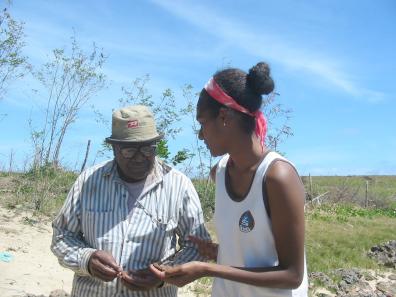French Govt to Fund Geoarchaeology Research
The French Government has provided funds to the University of the South Pacific’s Institute of Applied Science to carry out its third season of research at the earliest-known human settlement in Fiji – the Bourewa site near Natadola in the southwest of Viti Levu.

Caption: "Sepeti Matararaba of The Fiji Museum and USP student Faye Tamani with some newly-discovered finds of ancient pottery from the beach at Waikereira near Natadola, an area where some of the first people in Fiji were living about 900 BC".
The research team which will be led by Professor Patrick Nunn of the Department of Geography will likely comprise students and staff from USP, the Fiji Museum, the Australian National University, the University of Otago, Kyoto University, Université Laval (Canada), and the Université Française du Pacifique.
In December last year, a 17-person research team from the USP and the Fiji Museum carried out a second season of investigations over a three-week period at the Bourewa site. Professor Nunn led the team, supported by Mr Sepeti Matararaba of the Fiji Museum, Mr Conway Pene of the USP Geography Department, and Ms Roselyn Kumar of the USP's Institute of Applied Science.
The main purpose of this research was to accurately map the main human settlement at Bourewa and to continue its excavation. The settlement here was marked by abundant Lapita-age pottery and the remarkable discovery of a sculpted pottery face, believed to indicate the close affinity of the first settlers at Bourewa with Lapita settlements in the Bismarck Archipelago of Papua New Guinea. For this reason, the Bourewa site is thought likely to be the very first or 'founder' settlement in the Fiji islands.
The main settlement at Bourewa, on the coast about two km northwest of Natadola, was previously found to have been established as early as 1260 BC, and the excavations in 2004 found no evidence of an earlier date. What was more exciting was the size of the Bourewa settlement, and the discovery of a number of new Lapita-era settlements nearby. At its fullest extent, the Lapita settlement at Bourewa extended around 280 metres along the coastal flat and at least 70 metres inland, making it probable that it hosted perhaps 80 dwellings and perhaps about 300-350 people at its fullest extent.
The radiocarbon dates from this settlement show that it was established as much as 1260 BC and abandoned probably about 500-600 BC for unknown reasons. Towards the end of the history of this settlement, it became so full of people that several groups moved out to settle elsewhere. As discovered in December 2003, at around about 700 BC some moved to Rove, about three km further along the coast, and to Waikereira, the adjacent coastal flat. But, as discovered last December, some also left the Bourewa settlement to move to two other coastal flats nearby, one at Jugendar's Farm, one at Tomato Patch, probably also about 700 BC.
Another remarkable discovery made last December was that a Lapita settlement also existed about five km farther west, on Qoqo Island. Qoqo is a small bedrock island in the huge mangrove swamp that has developed around the mouth of the Tuva River. A small group of researchers visited Qoqo, along the recently-constructed road, and met the island's owner, Mr Peter Jones, who displayed his collection of pottery. This included a spectacular piece of Lapita pottery, and many more pieces were found during the subsequent excavations on Qoqo.
The Lapita settlement on Qoqo Island was established as much as 1000 BC but it is uncertain whether the settlers came from Bourewa or were later arrivals in this part of Fiji, perhaps from the eastern Solomon Islands. What is clear, from the remains of the shellfish and fish that the Qoqo people were consuming was that at the time they lived there, the island was not surrounded by mangroves, as it is today, but by coral reef.
Two caves were also excavated in this area last December but the results were not as exciting as hoped. Ram Lal Cave near Bourewa, proved to have experienced successive roof collapses and the research team found themselves hacking through blocks of limestone embedded in the cave floor. The cave named Qaramatatolu near Rove proved to have sediments in it that were more than two metres deep and full of indications of a human presence, like pieces of pottery, edible shells and animal bones. But no Lapita pottery was found at Qaramatatolu and the radiocarbon dates suggest that people occupied this cave only within the last 1000 years or so.
Ends.


 Carbon Market Watch: Going For Green - Is The Paris Olympics Winning The Race Against The Climate Clock?
Carbon Market Watch: Going For Green - Is The Paris Olympics Winning The Race Against The Climate Clock? New Zealand Defence Force: NZDF Working With Pacific Neighbours To Support Solomon Islands Election
New Zealand Defence Force: NZDF Working With Pacific Neighbours To Support Solomon Islands Election UN News: Ceasefire The Only Way To End Killing And Injuring Of Children In Gaza
UN News: Ceasefire The Only Way To End Killing And Injuring Of Children In Gaza ICHRP: US-Japan-Philippines Trilateral Summit Makes The Philippines A Battlefield For US-China Conflict
ICHRP: US-Japan-Philippines Trilateral Summit Makes The Philippines A Battlefield For US-China Conflict East West Center: Environmental Journalist Alexander Kaufman Receives East-West Center’s Inaugural Melvin M.S. Goo Writing Fellowship
East West Center: Environmental Journalist Alexander Kaufman Receives East-West Center’s Inaugural Melvin M.S. Goo Writing Fellowship Compassion in World Farming: Octopus Farm Must Be Stopped, Say Campaigners
Compassion in World Farming: Octopus Farm Must Be Stopped, Say Campaigners